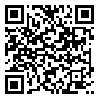Volume 17, Issue 3 (8-2023)
payavard 2023, 17(3): 278-289 |
Back to browse issues page
Download citation:
BibTeX | RIS | EndNote | Medlars | ProCite | Reference Manager | RefWorks
Send citation to:



BibTeX | RIS | EndNote | Medlars | ProCite | Reference Manager | RefWorks
Send citation to:
Erfannia L, Yazdani A. A Systematic Review of the Performance of Persian Language Mobile Applications in the Covid-19 Pandemic. payavard 2023; 17 (3) :278-289
URL: http://payavard.tums.ac.ir/article-1-7532-en.html
URL: http://payavard.tums.ac.ir/article-1-7532-en.html
1- Assistant Professor, Department of Health Information Management, Health Human Resources Research Center, Clinical Education Research Center, School of Health Management and Information Sciences, Shiraz University of Medical Sciences, Shiraz, Iran
Abstract: (718 Views)
Background and Aim: With the spread of the Corona pandemic, the statistics of the number of mobile health applications have grown significantly. This research was conducted with the aim of evaluating the content of Persian language applications in the management of Covid-19.
Material and Methods: In this review research, a systematic search for Persian language programs in the field of Covid-19 management was conducted in four mobile application markets including Myket, Bazzar, Google Play and App Store. The content of the programs was evaluated based on a researcher-made checklist, which was verified according 3 specialist comments, in the five axes of ease of use, education, monitoring, privacy and data sharing. Programs that received more than 50% of the evaluation score were introduced as selected programs. By removing duplicate programs, 119 programs were extracted, of which 21 programs entered the final stage of quality evaluation based on the inclusion and exclusion criteria and after a complete review of the content and capabilities.
Results: Based on the total points of the program, Safiran Salamat received the most score (31), Ac19 and mask were ranked next with 27 and 22 points, respectively. These three programs along with Corona Amar Tashkhis as fourth program received more than 50% of the content review and 17 other programs received less than 50% of the total score. Government has a great role in programs development (three program were government and one was non- government base). All 4 programs, had acceptable score in ease of use but none of them develop for user tracking. Pearson’s correlation test was used to test the relationship between the quality (total scores of apps) and the popularity (amount of downloads), and no significant correlation was observed.
Conclusion: The results of the present study showed that Iranian mobile applications have an acceptable performance in the fields of education and information sharing, but their low popularity makes the achievement of these goals far from expected. Marketing strategies can be effective as one of the useful policy in increasing the use of mobile health programs. Also, the inclusion of capabilities such as contact tracing and online consultations can be fruitful in the pursuit of goals.
Material and Methods: In this review research, a systematic search for Persian language programs in the field of Covid-19 management was conducted in four mobile application markets including Myket, Bazzar, Google Play and App Store. The content of the programs was evaluated based on a researcher-made checklist, which was verified according 3 specialist comments, in the five axes of ease of use, education, monitoring, privacy and data sharing. Programs that received more than 50% of the evaluation score were introduced as selected programs. By removing duplicate programs, 119 programs were extracted, of which 21 programs entered the final stage of quality evaluation based on the inclusion and exclusion criteria and after a complete review of the content and capabilities.
Results: Based on the total points of the program, Safiran Salamat received the most score (31), Ac19 and mask were ranked next with 27 and 22 points, respectively. These three programs along with Corona Amar Tashkhis as fourth program received more than 50% of the content review and 17 other programs received less than 50% of the total score. Government has a great role in programs development (three program were government and one was non- government base). All 4 programs, had acceptable score in ease of use but none of them develop for user tracking. Pearson’s correlation test was used to test the relationship between the quality (total scores of apps) and the popularity (amount of downloads), and no significant correlation was observed.
Conclusion: The results of the present study showed that Iranian mobile applications have an acceptable performance in the fields of education and information sharing, but their low popularity makes the achievement of these goals far from expected. Marketing strategies can be effective as one of the useful policy in increasing the use of mobile health programs. Also, the inclusion of capabilities such as contact tracing and online consultations can be fruitful in the pursuit of goals.
Keywords: Corona Virus, Covid-19, Mobile Application, Mobile HealthCorona Virus, Covid-19, Mobile Application, Mobile Health
| Rights and permissions | |
 |
This work is licensed under a Creative Commons Attribution-NonCommercial 4.0 International License. |





